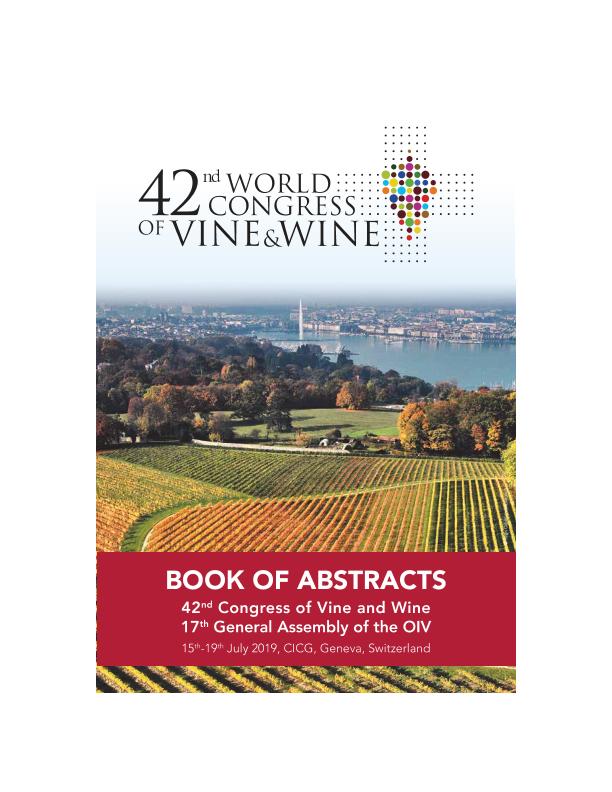Evento
Effect of varying leaf-fruit ratios on sensory attributes of Malbec wines from SHW-trellised vineyards
Ahumada, Gaston Emmanuel; Pirrone, Miguel; Catania, Anibal Alejandro; Fanzone, Martín Leandro; Belmonte, Marcelo; Giordano, Carla Valeria ; Gonzalez, Carina Veronica
; Gonzalez, Carina Veronica
 ; Gonzalez, Carina Veronica
; Gonzalez, Carina Veronica
Tipo del evento:
Congreso
Nombre del evento:
42nd World Congress of Vine & Wine and 17th general assembly of the International Organisation of Vine and Wine
Fecha del evento:
15/07/2019
Institución Organizadora:
International Organisation of Vine and Wine;
Título del Libro:
42nd World Congress of Vine & Wine and 17th general assembly of the International Organisation of Vine and Wine: Book of Abstracts
Editorial:
International Organisation of Vine and Wine
ISBN:
978 285 038 0105
Idioma:
Inglés
Clasificación temática:
Resumen
Argentina is the fifth world wine producer being Malbec its emblematic variety. Mendoza is the most important Argentinean wine region as it has the greatest implanted area and the most awarded wines. Vineyards for wine production are mainly conducted in the VSP trellis system. The single-high wire (SHW) system is a highly-productive, free cordon trellis system that is widespread in many important wine regions of the world. We evaluated, for the first time in Argentina, the effect of different leaf-fruit ratios on sensory attributes of Malbec wines from vineyards (Clon 598) conducted in SHW spur-pruned single cordon from Bodega Trapiche in Mendoza region (Winkler=V). We imposed different leaf-fruit ratios by two ways. In experiment (1), by varying canopy height at full bloom (H: 0.45, 0.80 m and without topping) and in experiment (2), by varying winter pruning severity (16, 24, 32 and > 32 countable buds m-2 reached by hand pruning, where > 32 simulated a box pruning). We characterized wines by exhaustive chemical analysis (anthocyanins, tannins, phenols, acidity, malic acid, pH, alcohol, glycerol, among others) and performed a descriptive analysis of the wines. Different leaf-fruit ratios resulted in clearly different wines both at biochemist- and sensory-level. The trained sensory panel revealed that wines from 0.80 m and without topping canopies had higher intensity of color, violet hue, acidity, alcohol and astringency than 0.45 m canopies. These descriptors were correlated with a higher anthocianyns, malic acid, alcohol, phenolic compounds and tannins concentration. In addition, these wines had a richer aroma profile (dry plum, red berry, red berry jam, tobacco, oak, red pepper) than 0.45 m-canopies that were identified as citric. On the other hand, the wines of the most extreme pruning levels (16 and >32 buds m-2) were similar in color intensity, violet hue, acidity, alcohol and astringency. These traits were also correlated with its corresponding biochemical variables. At aromatic level, these wines were described to have black pepper, oak, coffee and bell pepper among others. These results suggest that the modulation of leaf-fruit ratios by different approaches such as shoot topping or pruning severity lead us to obtain wines with different sensory attributes. This study allow us to adjust cultural practices intensity with the aim of producing Malbec wines with different typicity from SHW trellised-vineyards.
Palabras clave:
TRELLIS SYSTEM
,
LEAF-TO-FRUIT RATIO
,
OPEN CANOPY
,
MALBEC
Archivos asociados
Licencia
Identificadores
Colecciones
Eventos(IADIZA)
Eventos de INST. ARG DE INVEST. DE LAS ZONAS ARIDAS
Eventos de INST. ARG DE INVEST. DE LAS ZONAS ARIDAS
Eventos(IBAM)
Eventos de INST.DE BIOLOGIA AGRICOLA DE MENDOZA
Eventos de INST.DE BIOLOGIA AGRICOLA DE MENDOZA
Citación
Effect of varying leaf-fruit ratios on sensory attributes of Malbec wines from SHW-trellised vineyards; 42nd World Congress of Vine & Wine and 17th general assembly of the International Organisation of Vine and Wine; Ginebra; Suiza; 2019; 325-326
Compartir



